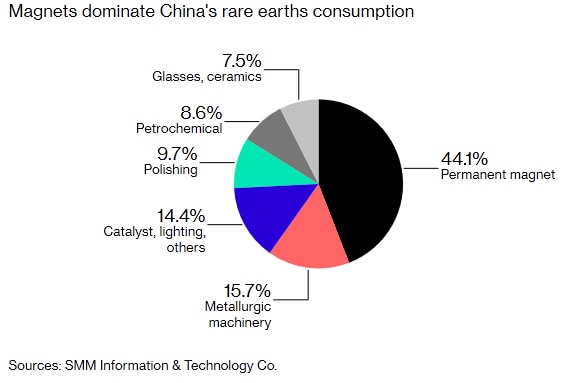Rare earth magnets are back in the headlines again. (Last updated 8/15/19)
As many of our customers have already noticed, there is more uncertainty in the market right now, a result of inflamed trade and tariff rhetoric from the U.S. and China. The media has already declared the situation to be a trade war, which has increased the volatility of prices.
We’ve received several calls and emails expressing concern over the situation, so we’ve created this blog to hopefully provide some answers. However, like gold, corn, and helium, not much is certain and we don’t want to cause unnecessary panic. We’ll try to stick to the facts and clarify when we’re sharing opinions.
1. What are “rare earths” anyway?
There are more than 15 elements classified as ‘rare earth,’ but the most significant of those to the manufacturing of rare earth magnets are Neodymium (Nd), Samarium (Sm), Dysprosium (Dy) Praseodymium (Pr) and Terbium (Tb). These elements are key to the production of rare earth magnets used in a wide range of industrial and consumer products.
2. Have supplies of rare earth magnets been impacted by all this tariff talk?
Magnet supplies are not currently being impacted by the tariff discussions. But that doesn’t mean there have not been issues with the supply chain. In May China banned imports of rare earth ores and concentrates from Myanmar and closed the port that had been the main crossing point for these exports. This has been attributed to concern over environmental damage caused by unregulated Myanmar mining practices, and China’s previously announced edict to reduce illegal rare earth production. These actions were already expected more than six months ago, so they are not a result of recent events.
The Office of the U.S.T.R. released two lists (4A and 4B, link below) on Tuesday, August 13, detailing the affected HTS subheadings being impacted on 9/1 and 12/15 respectively and permanent magnets (NdFeB, SmCo, ceramic and alnico) are not included on either list. https://ustr.gov/about-us/policy-offices/press-office/press-releases/2019/august/ustr-announces-next-steps-proposed
3. But the current trade war could still cause problems, right?
It’s impossible to know whether any threats made amidst ongoing negotiations will be fulfilled. For instance, just recently President Trump announced a 5% tariff on products from Mexico, but it was rescinded before it even went into effect.
Beijing has readied a plan to restrict exports of rare earths to the U.S. if needed, as both sides in the trade war dig in for a protracted dispute. However, industrial magnets are currently still exempt from the tariff lists that the U.S. Trade Representative (USTR) has already implemented, and from the additional tariffs that President Trump will be reviewing after the G20 Summit this month. Industrial magnets made in China are imported as a finished good, not as a rare earth mineral.
4. What happens if China makes good on its threat?
While the majority of rare earth magnets originate in China, they are manufactured in many other countries throughout the world, and production increases every year. Prices may go up for a while, but our suppliers believe that prices will not increase to the levels seen in 2011 – the last time China curtailed rare earth mining.
A protracted reduction in supply from China will only further accelerate production now underway in Australia, Canada, Brazil and other nations. Here in the U.S; California’s Mountain Pass Rare Earth Mine once supplied most of the world’s rare-earth elements. Recently, it was announced that the mine will begin its own processing operation by next year.
5. What is the Trump administration doing to get ahead of this situation?
On July 22nd, Trump issued five memos sent to the secretary of defense, making an official determination under Section 303 of the Defense Production Act of 1950 that domestic production, separation and manufacturing of rare earths is “essential to the national defense” of the U.S. Read more on that here: https://www.linkedin.com/pulse/president-trump-formally-determines-rare-…
6. What are you hearing from your suppliers?
We consistently hear that market uncertainty will inevitably continue to affect prices, however, the consensus among our suppliers is that there is no forecasted shortage of rare earth magnets for the markets Adams serves. Control may tighten on rare earth mines or rare earth oxides, but an embargo on finished products such as magnets or magnet assemblies is less likely.
You can be assured that Adams Magnetic Products Company is monitoring the situation and will continue to do so in an effort to protect our customers’ interests. We appreciate our partnership with you and will keep you informed of any further developments that could affect your product designs or supply chain. If you have any questions, please let us know.
More Negative than Positive: Read on for Media Spin
Positive outlook:
Neutral links:
https://www.miningnewsnorth.com/story/2019/08/01/news/trump-rare-earths-…
Negative outlook:
https://nationalinterest.org/feature/what-rare-earths-tell-us-about-chin…
https://www.bloomberg.com/news/articles/2019-06-05/why-tiny-magnets-coul…
Tags: rare earth magnets






